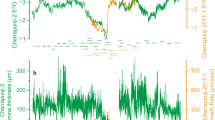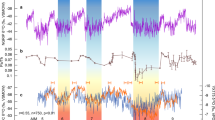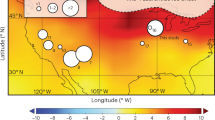Abstract
An interhemispheric hydrologic seesaw—in which latitudinal migrations of the Intertropical Convergence Zone (ITCZ) produce simultaneous wetting (increased precipitation) in one hemisphere and drying in the other—has been discovered in some tropical and subtropical regions1,2,3. For instance, Chinese and Brazilian subtropical speleothem (cave formations such as stalactites and stalagmites) records show opposite trends in time series of oxygen isotopes (a proxy for precipitation variability) at millennial to orbital timescales2,3, suggesting that hydrologic cycles were antiphased in the northerly versus southerly subtropics. This tropical to subtropical hydrologic phenomenon is likely to be an initial and important climatic response to orbital forcing3. The impacts of such an interhemispheric hydrologic seesaw on higher-latitude regions and the global climate system, however, are unknown. Here we show that the antiphasing seen in the tropical records is also present in both hemispheres of the mid-latitude western Pacific Ocean. Our results are based on a new 550,000-year record of the growth frequency of speleothems from the Korean peninsula, which we compare to Southern Hemisphere equivalents4. The Korean data are discontinuous and derived from 24 separate speleothems, but still allow the identification of periods of peak speleothem growth and, thus, precipitation. The clear hemispheric antiphasing indicates that the sphere of influence of the interhemispheric hydrologic seesaw over the past 550,000 years extended at least to the mid-latitudes, such as northeast Asia, and that orbital-timescale ITCZ shifts can have serious effects on temperate climate systems. Furthermore, our result implies that insolation-driven ITCZ dynamics may provoke water vapour and vegetation feedbacks in northern mid-latitude regions and could have regulated global climate conditions throughout the late Quaternary ice age cycles.
This is a preview of subscription content, access via your institution
Access options
Subscribe to this journal
Receive 51 print issues and online access
$199.00 per year
only $3.90 per issue
Buy this article
- Purchase on Springer Link
- Instant access to full article PDF
Prices may be subject to local taxes which are calculated during checkout



Similar content being viewed by others
References
Severinghaus, J. P. Monsoons and meltdowns. Science 326, 240–241 (2009)
Wang, X. et al. Wet periods in northeastern Brazil over the past 210 kyr linked to distant climate anomalies. Nature 432, 740–743 (2004)
Cruz, F. W., Jr et al. Insolation-driven changes in atmospheric circulation over the past 116,000 years in subtropical Brazil. Nature 434, 63–66 (2005)
Ayliffe, L. K. et al. 500 ka precipitation record from southeastern Australia: evidence for interglacial relative aridity. Geology 26, 147–150 (1998)
Nakagawa, T. et al. Regulation of the monsoon climate by two different orbital rhythms and forcing mechanisms. Geology 36, 491–494 (2008)
Kim, J.-M. & Kucera, M. Benthic foraminifer record of environmental changes in the Yellow Sea (Hwanghae) during the last 15,000 years. Quat. Sci. Rev. 19, 1067–1085 (2000)
Lim, H. S. et al. Vertebrate burrows in late Pleistocene paleosols at Korean Palaeolithic sites and their significance as a stratigraphic marker. Quat. Res. 68, 213–219 (2007)
Yi, S. & Kim, S.-J. Vegetation changes in western central region of Korean Peninsula during the last glacial (ca. 21.1–26.1 cal kyr BP). Geosci. J. 14, 1–10 (2010)
Korea Meteorological Administration. http://web.kma.go.kr/eng/biz/climate_01.jsp (2011)
Chough, S. K. et al. Tectonic and sedimentary evolution of the Korean peninsula: a review and new view. Earth Sci. Rev. 52, 175–235 (2000)
Jo, K., Woo, K. S., Hong, G. H., Kim, S. H. & Suk, B. C. Rainfall and hydrological controls on speleothem geochemistry during climatic events (droughts and typhoons): an example from Seodong Cave, Republic of Korea. Earth Planet. Sci. Lett. 295, 441–450 (2010)
Lisiecki, L. E. & Raymo, M. E. A. Pliocene-Pleistocene stack of 57 globally distributed benthic δ18O records. Paleoceanography 20, PA1033 (2005)
Berger, A. & Loutre, M. F. Insolation values for the climate of the last 10 million years. Quat. Sci. Rev. 10, 297–317 (1991)
Wang, Y. et al. Millennial- and orbital-scale changes in the East Asian monsoon over the past 224,000 years. Nature 451, 1090–1093 (2008)
Cheng, H. et al. The climatic cyclicity in semiarid-arid central Asia over the past 500,000 years. Geophys. Res. Lett. 39, L01705 (2012)
Jouzel, J. et al. Orbital and millennial Antarctic climate variability over the past 800,000 years. Science 317, 793–796 (2007)
Winograd, I. J. et al. Continuous 500,000-year climate record from vein calcite in Devils Hole, Nevada. Science 258, 255–260 (1992)
Tan, M. et al. Cyclic rapid warming on centennial-scale revealed by a 2650-year stalagmite record of warm season temperature. Geophys. Res. Lett. 30, 1617 (2003)
Baker, A., Smart, P. L. & Ford, D. C. Northwest European palaeoclimate as indicated by growth frequency variations of secondary calcite deposits. Palaeogeogr. , Palaeoecol.. Palaeoclimatol. 100, 291–301 (1993)
Spötl, C., Mangini, A., Frank, N., Eichstädter, R. & Burns, S. J. Start of the last interglacial period at 135 ka: evidence from a high Alpine speleothem. Geology 30, 815–818 (2002)
Vaks, A. et al. Speleothems reveal 500,000-year history of Siberian permafrost. Science 340, 183–186 (2013)
Asmerom, Y., Polyak, V. J. & Burns, S. J. Variable winter moisture in the southwestern United States linked to rapid glacial climate shifts. Nature Geosci. 3, 114–117 (2010)
Whittaker, T. E., Hendy, C. H. & Hellstrom, J. C. Abrupt millennial-scale changes in intensity of Southern Hemisphere westerly winds during marine isotope stages 2–4. Geology 39, 455–458 (2011)
Ziegler, M., Tuenter, E. & Lourens, L. J. The precession phase of the boreal summer monsoon as viewed from the eastern Mediterranean (ODP Site 968). Quat. Sci. Rev. 29, 1481–1490 (2010)
Weber, M. E. et al. Interhemispheric ice-sheet synchronicity during the Last Glacial Maximum. Science 334, 1265–1269 (2011)
Stager, J. C., Ryves, D. B., Chase, B. M. & Pausata, F. S. R. Catastrophic drought in the Afro-Asian monsoon region during Heinrich Event 1. Science 331, 1299–1302 (2011)
Soden, B. J., Wetherald, R. T., Stenchikov, G. L. & Robock, A. Global cooling after the eruption of Mount Pinatubo: a test of climate feedback by water vapor. Science 296, 727–730 (2002)
Kutzbach, J., Bonan, G., Foley, J. & Harrison, S. P. Vegetation and soil feedbacks on the response of the African monsoon to orbital forcing in the early to middle Holocene. Nature 384, 623–626 (1996)
Cheddadi, R. & Bar-Hen, A. Spatial gradient of temperature and potential vegetation feedback across Europe during the late Quaternary. Clim. Dyn. 32, 371–379 (2009)
McCarthy, M. P. et al. The influence of vegetation on the ITCZ and South Asian monsoon in HadCM3. Earth Syst. Dyn. 3, 87–96 (2012)
Jo, K. et al. Textural and carbon isotopic evidence of monsoonal changes recorded in a composite-type speleothem from Korea since MIS 5a. Quat. Res. 74, 100–112 (2010)
Jo, K. et al. Holocene and Eemian climatic optima in the Korean Peninsula based on textural and carbon isotopic records from the stalagmite of the Daeya Cave, South Korea. Quat. Sci. Rev. 30, 1218–1231 (2011)
Edwards, R. L., Chen, J. H. & Wasserburg, G. J. 238U–234U–230Th–232Th systematics and the precise measurement of time over the past 500,000 years. Earth Planet. Sci. Lett. 81, 175–192 (1987)
Cheng, H. et al. Ice age terminations. Science 326, 248–252 (2009)
Cheng, H. et al. The half-lives of uranium-234 and thorium-230. Chem. Geol. 169, 17–33 (2000)
Cheng, H. et al. A new generation of 230Th dating techniques: tests of precision and accuracy. Geochim. Cosmochim. Acta 72, A157 (2008)
Ludwig, K. R. Isoplot 3.00: a Geochronological Toolkit for Microsoft Excel 70 (Univ. of California, Special Publication 4, 2003)
He, X., Wang, J.-L., Li, H., Cheng, H. & Yuan, D. Growth pattern and depositional feature of stalagmites in the karst of Chongqing, SW China: climatic implications. Karst Waters I Spec. Pub. 10, 31–32 (2006)
Hendy, C. The isotopic geochemistry of speleothems—I. The calculation of the effects of different modes of formation on the isotopic composition of speleothems and their applicability as paleoclimatic indicators. Geochim. Cosmochim. Acta 35, 801–824 (1971)
Dorale, J. A. & Liu, Z. Limitations of Hendy Test criteria in judging the paleoclimatic suitability of speleothems and the need for replication. J. Caves Karst Stud. 71, 73–80 (2009)
Wang, Y. J. et al. A high-resolution absolute-dated late Pleistocene monsoon record from Hulu Cave, China. Science 294, 2345–2348 (2001)
Yuan, D. et al. Timing, duration, and transitions of the last interglacial Asian mosoon. Science 304, 575–578 (2004)
Chae, N. Annual variation of soil respiration and precipitation in a temperate forest (Quercus serrata and Carpinus laxiflora) under East Asian monsoon climate. J. Plant Biol. 54, 101–111 (2011)
Vaks, A. et al. Paleoclimate and location of the border between Mediterranean climate region and the Saharo-Arabian Desert as revealed by speleothems from the northern Negev Desert, Israel. Earth Planet. Sci. Lett. 249, 384–399 (2006)
Dobinski, W. et al. Permafrost. Earth Sci. Rev. 108, 158–169 (2011)
Ersek, V. et al. Environmental influences on speleothem growth in southwestern Oregon during the last 380,000 years. Earth Planet. Sci. Lett. 279, 316–325 (2009)
Kim, S.-J. et al. High-resolution climate simulation of the last glacial maximum. Clim. Dyn. 31, 1–16 (2008)
Levavasseur, G. et al. Present and LGM permafrost from climate simulations: contribution of statistical downscaling. Clim. Past Discuss. 7, 1647–1692 (2011)
Hennig, G. J., Grun, R. & Brunnacker, K. Speleothems, travertines, and paleoclimates. Quat. Res. 20, 1–29 (1983)
Gordon, D. et al. Dating the late Pleistocene interglacial and interstadial periods in the United Kingdom from speleothem growth frequency. Quat. Res. 31, 14–26 (1989)
North Greenland Ice Core Project members. High-resolution record of Northern Hemisphere climate extending into the last interglacial period. Nature 431, 147–151 (2004)
Bar-Matthews, M. Ayalon, A. & Kaufman, A. Timing and hydrological conditions of sapropel events in the Eastern Mediterranean, as evident from speleothems, Soreq Cave, Israel. Chem. Geol. 169, 145–156 (2000)
Martinson, D. G. et al. Age dating and the orbital theory of the ice ages: development of a high-resolution 0 to 300,000 year chronostratigraphy. Quat. Res. 27, 1–29 (1987)
Linge, H., Lauritzen, S.-E. & Lundberg, J. Stable isotope stratigraphy of a late last interglacial speleothem from Rana, northern Norway. Quat. Res. 56, 155–164 (2001)
Burns, S. J., Fleitmann, D., Matter, A., Neff, U. & Mangini, A. Speleothem evidence from Oman for continental pluvial events during interglacial periods. Geology 29, 623–626 (2001)
Fleitmann, D. et al. Holocene and Pleistocene pluvial periods in Yemen, southern Arabia. Quat. Sci. Rev. 30, 783–787 (2011)
Partin, J. W., Cobb, K. M., Adkins, J. F., Clark, B. & Fernandez, D. P. Millennial-scale trends in west Pacific warm pool hydrology since the Last Glacial Maximum. Nature 449, 452–455 (2007)
Griffiths, M. L. et al. Increasing Australian-Indonesian monsoon rainfall linked to early Holocene sea-level rise. Nature Geosci. 2, 636–639 (2009)
Cai, Y. et al. Large variations of oxygen isotopes in precipitation over south-central Tibet during Marine Isotope Stage 5. Geology 38, 243–246 (2010)
Acknowledgements
We thank the Kangwon National University Cave Investigation Club (KNUCIC) for collecting some of the speleothem samples, S. S. Lee for the supplementary statistical test and K. R. Ludwig for providing the analytical software package. This research was a part of the project titled K-IODP (KIGAM; Korea Institute of Geoscience and Mineral Resources) funded by the Ministry of Oceans and Fisheries, Korea. This project was also partially supported by Basic Research Project (GP2009-005) of KIGAM, grants NSFC 41230524 and NBRP 2013CB955902 (to H.C.) and US NSF grants 1103403 and 1337693 (to R.L.E. and H.C.).
Author information
Authors and Affiliations
Contributions
K.-n.J. collected most of the information and wrote the first draft of the manuscript. K.S.W. discussed the palaeoclimatic implications of the data and improved the manuscript. S.Y. commented on the palaeoclimatic interpretations. D.Y.Y. and H.S.L. provided research grants to K.S.W. and K.-n.J. for obtaining data on caves and speleothems. Y.W. provided the stable isotope data, and H.C. and R.L.E. supplied some of the 230Th/234U dating results. All authors approved the submitted form of the manuscript.
Corresponding author
Ethics declarations
Competing interests
The authors declare no competing financial interests.
Extended data figures and tables
Extended Data Figure 1 Temperature, humidity, and partial pressure of CO2 in the Daeya and Eden caves.
a, b, The atmospheric conditions in Daeya cave (a) and Eden cave (b).
Extended Data Figure 2 Plot of 230Th dating results for all speleothem samples from the Korean peninsula.
Error bars show the 2σ analytical uncertainty, including the error from the detrital 230Th. Grey horizontal bars divide each sample.
Extended Data Figure 3 Plot of relative probability constructed by summing the individual ages of all the dated samples.
Panel a shows all dates, and panel b presents the relative probability density, except for samples that grew only within the Holocene (Supplementary Table 1).
Extended Data Figure 4 The age data along the growth axes of three speleothem samples.
The yellow vertical bars represent the minimum periods of major growth intervals. a, ED1 from Eden cave. b, JM3 from Joongmal cave. c, JM2 from Joongmal cave. Error bars represent 2σ analytical uncertainty with error from the detrital 230Th.
Extended Data Figure 5 Frequency distributions of speleothem growth in the Northern Hemisphere.
Extended Data Figure 6 Comparison of the growth frequency record from Korean speleothems with other high-resolution palaeoclimatic records from high-latitude polar to low-latitude tropical regions since the penultimate glacial termination.
a, δ18O record of Sanbao cave in central China15. b, Summer insolation at 65° N13. c, δ18O record from the North Greenland Ice Core Project (NGRIP)51; VSMOW is Vienna standard mean ocean water. d, Growth frequency record of Korean speleothems. S numbers indicate Mediterrean sapropel events. Periods of high growth frequency are shown in light brown. e, δ18O record for Soreq cave in the eastern Mediterranean region52. f, Radiolarian temperature record from marine sediment core RC11-120 in the Southern Ocean53. The present values of each proxy record are also shown by horizontal dashed lines on each proxy curve. Palaeoclimatic signals from mid-latitude regions display both low- and high-latitude characteristics.
Extended Data Figure 7 Scenario of palaeoclimate changes linked with the interhemispheric hydrologic seesaw.
Background image is from NASA Eclipse Web Site (http://eclipse.gsfc.nasa.gov/transit/TV2004.html). a, Peak interglacial periods are characterized by large geographic variations in the seasonal ITCZ and strong atmospheric meridional overturning circulations. b, Stadial periods show intermediate climatic conditions between those of peak interglacial and full glacial periods. c, Interstadial periods show intermediate climatic conditions between those of peak interglacial and full glacial periods. d, Full glacial periods are characterized by small geographic variations in the seasonal ITCZ and weak atmospheric meridional overturning circulations. Conceptual geographic ranges of estimated permafrost and ice sheets during stadial periods are shown by grey- and white-coloured areas, respectively48. Also shown are the cave locations of active speleothem growth during each time period (red dots)4,15,21,42,49,52,54,55,56,57,58,59. See Methods for a detailed description of the scenario.
Supplementary information
Supplementary Table 1
230Th dating results for speleothem samples from the Korean Peninsula. (XLSX 37 kb)
Rights and permissions
About this article
Cite this article
Jo, Kn., Woo, K., Yi, S. et al. Mid-latitude interhemispheric hydrologic seesaw over the past 550,000 years. Nature 508, 378–382 (2014). https://doi.org/10.1038/nature13076
Received:
Accepted:
Published:
Issue Date:
DOI: https://doi.org/10.1038/nature13076
This article is cited by
-
Solar forcing of early Holocene droughts on the Yucatán peninsula
Scientific Reports (2021)
-
Asynchronous multi-decadal time-scale series of biotic and abiotic responses to precipitation during the last 1300 years
Scientific Reports (2020)
-
Speleothem growth intervals reflect New Zealand montane vegetation response to temperature change over the last glacial cycle
Scientific Reports (2020)
-
Orbital-scale nonlinear response of East Asian summer monsoon to its potential driving forces in the late Quaternary
Climate Dynamics (2018)
-
Tropical rainfall over the last two millennia: evidence for a low-latitude hydrologic seesaw
Scientific Reports (2017)
Comments
By submitting a comment you agree to abide by our Terms and Community Guidelines. If you find something abusive or that does not comply with our terms or guidelines please flag it as inappropriate.



